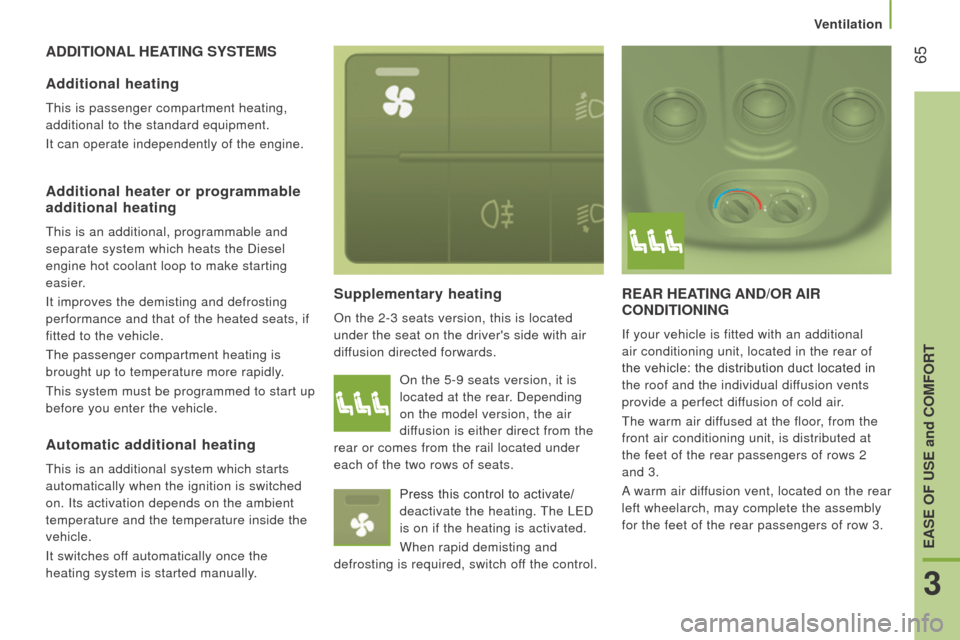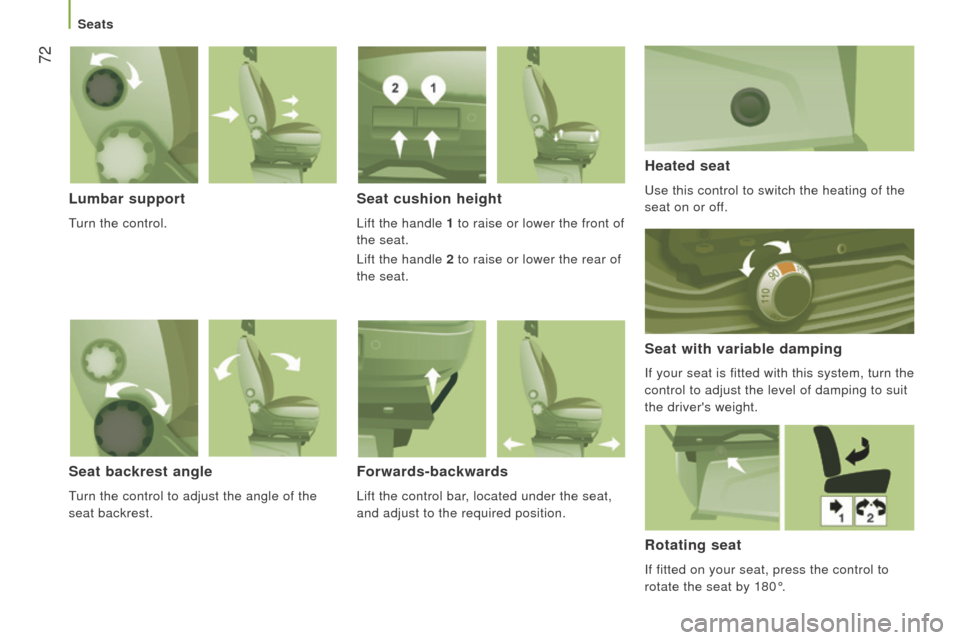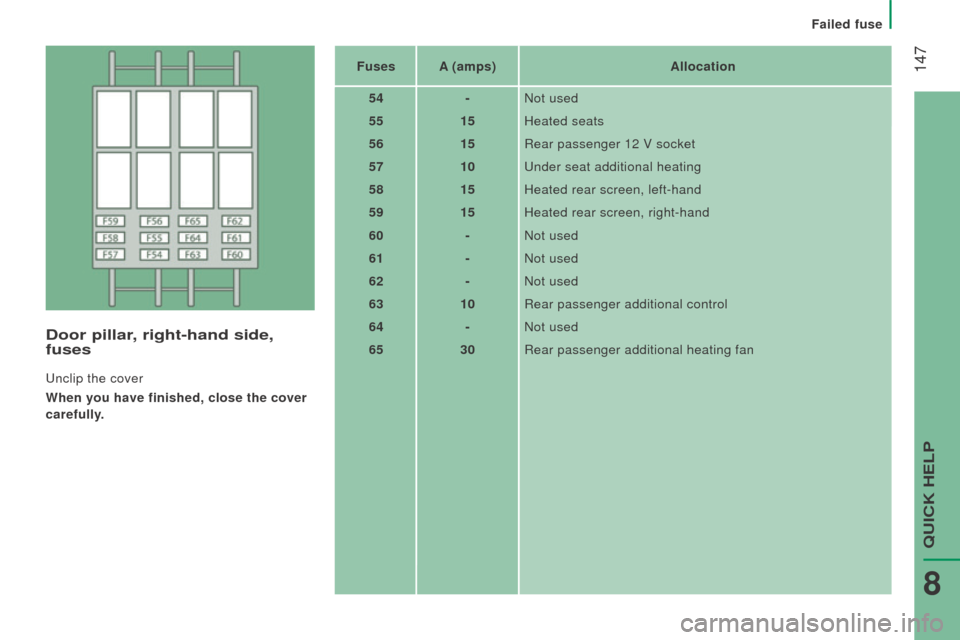2015.5 Citroen JUMPER RHD Heat seat
[x] Cancel search: Heat seatPage 4 of 276

2
contents
3. EASE OF u SE and c
OMFO rt 44-86
Lighting control stalk 45
Wipers 48
Cruise control
49
Speed limiter
55
Demisting and
defrosting
59
Heating / Manual air conditioning
61
Digital air conditioning
63
Additional heating
systems
65
Rear Heating /
Air Conditioning
65
Programmable
additional heating
67
Front seats
71
Front bench seat
73
Rear seats
74
Front fittings
76
Rear fittings
81
Exterior fittings
84
Mirrors
85
Electric windows
86
Presentation
4
Exterior
6
Interior
7
Instruments and controls
9
T
echnical data - Maintenance
10
Environment
11
Eco-driving
12
1. OVErVIEW 4-15 4. t E c H n OLOGY on
BOA rd 87-97
Vehicle configuration 87
T rip computer 92
T
achograph
93
Rear parking sensors
94
Reversing camera
95
Pneumatic suspension
96
2. rEAdY tO GO 14-43
Remote control 14
Key 16
Alarm
19
Front / rear doors
20
Load space
22
Instrument panel
23
W
arning/indicator lamps
24
Fuel gauge
32
T
emperature indicator
32
Tyre under-inflation detection
33
Service indicator
35
Gearbox and steering
wheel
36
Gear shift indicator
36
Starting and
switching off
38
Hill start assist
39
Stop & Start
40
Driving
recommendations
43
This symbol informs you
of equipment which is
specific to the Combi /
Minibus model. Child lock.Rear heating / air
conditioning / Rear
seats / bench seats.
Reading lamps. Sliding
side windows.
Page 9 of 276

7
Seat belts 106-108
Airbags 110-112
Deactivating the passenger's front airbag
1
11, 114
Parking brake, handbrake
98
Front seats, adjustments
71-72
Seat with variable damping
72
2-seat bench
73
Child seats
1
13-116, 119-120
12 volt socket, USB port
79, 81-82 Battery (+), charging,
starting
142-144
Earth point (-)
128, 142
Fuses in the right hand door pillar 145, 147
IntErIOr
Seats / rear bench
seats 74-75
Rear heating /
air conditioning
65-66
Sliding side door
20
Folding foot board
84
Sliding side windows
83
Rear view mirror
85
Lane departure warning system
105
Cab courtesy lamp
80, 152
Changing a courtesy lamp bulb
149, 152
ISOFIX mountings
1
17-118
Tools, jack
76, 156
Accessories
124
Load space
81-82
●
stowing rings,
●
load retainer
,
●
interior roof box,
●
side trims,
●
12 volt socket,
●
courtesy lamp,
T
orch 83
1
OVERVIEW
Location
Page 14 of 276

12
EcO-drIVInG
Optimise the use of your gearbox
With a manual gearbox, move off gently and change up without
waiting. While accelerating changing up early. If your vehicle has
the system, the gear shift indicator invites you to engage the most
suitable gear; follow its instructions as soon as it is displayed in
the instrument panel.
drive smoothly
Maintain a safe distance between vehicles, use engine
braking rather than the brake pedal, and press the accelerator
progressively. These practices contribute towards a reduction in
fuel consumption and CO
2 emissions and also helps reduce the
background traffic noise.
If your vehicle has cruise control, make use of the system at
speeds above 20 mph (30 km/h) when the traffic is flowing well.
control the use of your electrical equipment
Before moving off, if the passenger compartment is too warm,
ventilate it by opening the windows and air vents before using the
air conditioning.
Above 30 mph (50 km/h), close the windows and leave the air
vents open.
Remember to make use of equipment that can help keep the
temperature in the passenger compartment down (window
blinds...).
Switch off the air conditioning, unless it has automatic digital
regulation, as soon as the desired temperature is attained.
Switch off the demisting and defrosting controls, if not automatic.
Switch off the heated seat as soon as possible.
Switch off the headlamps and front foglamps when the level of
light does not require their use.
Eco-driving is a range of everyday practices that allow the motorist to \
optimise their fuel consumption and CO
2 emissions.
Avoid running the engine before moving off, particularly in winter;
your vehicle will warm up much faster while driving.
As a passenger, if you avoid connecting your multimedia devices
(film, music, video game...), you will contribute towards limiting the\
consumption of electrical energy, and so of fuel.
Disconnect your portable devices before leaving the vehicle.
Motoring & the Environment
Page 42 of 276

40The Stop & Start system puts the engine
temporarily into standby - ST OP mode -
during stops in the traffic (red lights, traffic
jams, or other...). The engine restarts
automatically - START mode - as soon as
you want to move off. The restart takes
place instantly, quickly and silently.
Perfect for urban use, the Stop & Start
system reduces fuel consumption and
exhaust emissions and offers the comfort of
complete silence when stationary.
StOP & StA rt
Operation
Going into engine StOP mode
With the vehicle stationary, put the gear
lever into neutral, then release the clutch
pedal.
-
This indicator lamp comes on
in the instrument panel and
the engine goes into standby. Automatic stopping of the engine is
only possible after the vehicle has
exceed a speed of about 6 mph (10 km/h),
to avoid repeated stopping of the engine
when driving slowly.
Never leave your vehicle with out first
turning off the ignition with the key.
Never refuel with the engine in STOP
mode; you must switch off the ignition
with the key. Special cases: S
t
OP
mode unavailable
The STOP mode is not invoked when:
-
the system is initialising,
-
the driver's door is open,
-
the driver's seat belt is not fastened,
-
the air conditioning is running,
-
the heated rear screen is on,
-
the windscreen wiper is on fast wipe,
-
reverse gear is engaged, for a parking
manoeuvre,
-
some special conditions (battery
charge, engine temperature, particle
filter regeneration, braking assistance,
ambient temperature...) where the
engine is needed to assure control of a
system.
This indicator lamp in the
instrument panel flashes for a
few seconds, then goes off.
t
his operation is perfectly normal.
Starting and switching off
Page 67 of 276

65AddItIOnAL HEAt I n G SYS t EMS
Supplementary heating
On the 2-3 seats version, this is located
under the seat on the driver's side with air
diffusion directed forwards.
rEAr HEAtI n G A nd/ O r AI r
c O nd I t IO n I n G
If your vehicle is fitted with an additional
air conditioning unit, located in the rear of
the vehicle: the distribution duct located in
the roof and the individual diffusion vents
provide a perfect diffusion of cold air.
The warm air diffused at the floor, from the
front air conditioning unit, is distributed at
the feet of the rear passengers of rows 2
and 3.
A warm air diffusion vent, located on the rear
left wheelarch, may complete the assembly
for the feet of the rear passengers of row 3.
Additional heating
This is passenger compartment heating,
additional to the standard equipment.
It can operate independently of the engine.
Additional heater or programmable
additional heating
This is an additional, programmable and
separate system which heats the Diesel
engine hot coolant loop to make starting
easier.
It improves the demisting and defrosting
performance and that of the heated seats, if
fitted to the vehicle.
The passenger compartment heating is
brought up to temperature more rapidly.
This system must be programmed to start up
before you enter the vehicle. On the 5-9 seats version, it is
located at the rear. Depending
on the model version, the air
diffusion is either direct from the
rear or comes from the rail located under
each of the two rows of seats.
Press this control to activate/
deactivate the heating. The LED
is on if the heating is activated.
When rapid demisting and
defrosting is required, switch off the control.
Automatic additional heating
This is an additional system which starts
automatically when the ignition is switched
on. Its activation depends on the ambient
temperature and the temperature inside the
vehicle.
It switches off automatically once the
heating system is started manually.
3
EASE OF uSE and cOMFOrt
Ventilation
Page 68 of 276

66
Activation/deactivation
This control, located on the
control panel at the right-hand
end of the dashboard, enables
you to activate/deactivate the
operation of the rear controls from the
driver's seat.
The first press activates (LED on).
A second press deactivates (LED off). To deactivate the blower, place the control in
position 0.
However, a safety device will ventilate the
rear circuit automatically, even if the control
is in position 0, to prevent the formation of
condensation.
Air flow
c
omfort value adjustment
- on the blue, produces
cool air,
-
on the red, produces heating
of the ambient air.
The OFF control on the "Mono-zone" central
control panel switches the function off. Control positioned:
The force of the blown air, via
the vents, varies from 1 to the
strongest 4.
To obtain a comfortable level of
ambient air, remember to adjust
this control.
Ventilation
Page 74 of 276

72
Lumbar support
Turn the control.
Seat cushion height
Lift the handle 1 to raise or lower the front of
the seat.
Lift the handle 2 to raise or lower the rear of
the seat.
Heated seat
Use this control to switch the heating of the
seat on or off.
Seat with variable damping
If your seat is fitted with this system, turn the
control to adjust the level of damping to suit
the driver's weight.
Seat backrest angle
Turn the control to adjust the angle of the
seat backrest.
Forwards-backwards
Lift the control bar, located under the seat,
and adjust to the required position.
rotating seat
If fitted on your seat, press the control to
rotate the seat by 180°.
Seats
Page 149 of 276

147
door pillar, right-hand side,
fuses
Unclip the cover
When you have finished, close the cover
carefully. Fuses
A (amps) Allocation
54 -Not used
55 15Heated seats
56 15Rear passenger 12 V socket
57 10Under seat additional heating
58 15Heated rear screen, left-hand
59 15Heated rear screen, right-hand
60 -Not used
61 -Not used
62 -Not used
63 10Rear passenger additional control
64 -Not used
65 30Rear passenger additional heating fan
QUICK HELP
8
Failed fuse